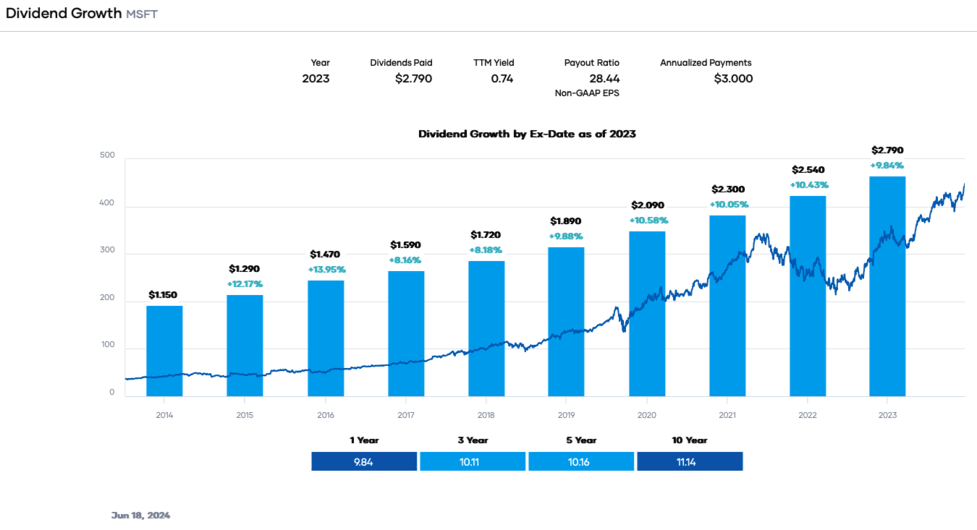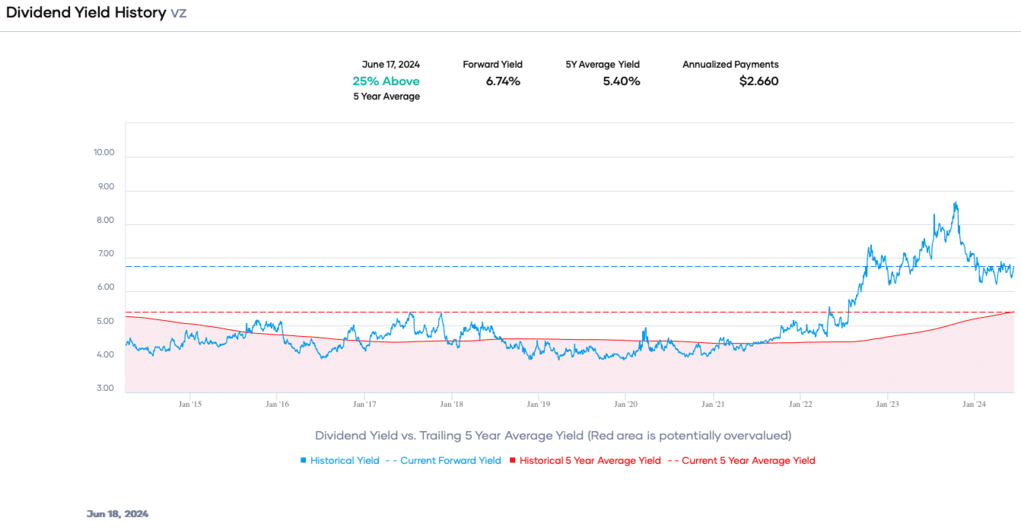3 Wide Moat Stocks For Long-Term Dividend Growth
Image Source: Unsplash
An important factor for investors to consider is the concept of market leadership. There are many ways to express market leadership. Legendary investor Warren Buffett popularized the idea of economic moats.
Broadly speaking, companies with market leadership have top places in their respective industries, with durable competitive advantages that permit them to generate long-term growth. This makes it very difficult for competitors to gain market share versus these businesses.
In turn, this allows for above-average growth rates and industry-leading profit margins. Many wide-moat stocks return cash to shareholders through regular dividends.
The 3 dividend stocks below all lead their industries with wide moats and have long histories of dividend growth.
3 Wide Moat Stocks
1: Microsoft Corporation (MSFT)
Microsoft (MSFT) is one of the largest companies in the world in terms of market capitalization and is a leading software player. It produces and sells a wide range of products, but the most important is its operating systems (‘Windows’) and its Microsoft Office suite, which are used by businesses and consumers. it is our number-one pick for wide-moat stocks that pay a dividend.
Microsoft enjoys a wide and very durable moat in both of these key business franchises. The stock has a market capitalization above $3 trillion.
Microsoft reported financial results for the third quarter of fiscal 2024 in late April. Iits fiscal year ends June 30th. The company grew its revenue by 17% over last year’s quarter. Growth came from Intelligent Cloud and Productivity & Business Processes, which grew 21% and 12%, respectively. Sales of Azure, Microsoft’s high-growth cloud platform, rose 31%.
As a result, earnings-per-share grew 20%, from $2.45 to $2.94, and surpassed the analysts’ consensus by $0.10. Microsoft has surpassed the analysts’ consensus in 21 of the last 23 quarters.
Thanks to Azure, which has grown tremendously, Microsoft’s cloud business is snowballing. The Office product range, which had been a low-growth cash cow for years, is also showing strong growth rates after Microsoft changed its business model towards the Office 365 software-as-a-service (SaaS) system. Becasue of low variable costs, the company should sustain a solid earnings growth rate for the foreseeable future.
Artificial intelligence is another growth driver, as Microsoft has begun to prove that it can monetize its leadership in this booming field. The markets Microsoft addresses continue to grow, with cloud computing and artificial intelligence being the most compelling.
MSFT has increased its dividend for 22 consecutive years making it a Dividend Contender and currently yields 0.7%.
(Click on image to enlarge)

Source: Portfolio Insight
2: Verizon Communications (VZ)
Verizon Communications is one of the leading wireless carriers in the country. Wireless contributes three-quarters of total revenues, and broadband and cable services account for the remainder. The company’s network covers ~300 million people and 98% of the U.S.
Due to its market leadership, Verizon has increased its dividends by 19 consecutive years. The company continues to generate modest growth. On April 22nd, 2024, Verizon reported first quarter results for the period ending March 31st, 2024. Revenue improved 0.3% for the quarter to $33 billion, but this was $230 million below estimates. Adjusted earnings-per-share of $1.15 compared unfavorably to $1.20 in the prior year, but this was $0.03 more than expected. For the quarter, Verizon had postpaid phone net losses of 68K, fewer than the net losses of 127K that the company had in the same quarter a year ago. Retail postpaid net additions totaled 253K. Wireless revenue increased by 3.3% to $19.5 billion, while the Consumer segment increased by 0.8% to $25.1 billion.
Broadband added 389K net new customers during the period, the seventh consecutive quarter with at least 300K net additions. This included 151K fixed wireless net additions, a 10.2% increase from the prior year, and the best quarterly result to date. Fios additions totaled 53K. The wireless retail postpaid phone churn rate remains low at 0.89%.
Free cash flow grew 17.4% to $2.7 billion. Verizon also reaffirmed its guidance for 2024. The company still expects wireless service revenue to grow 2% to 3.5% and adjusted earnings-per-share in a range of $4.50 to $4.70. Due to its market leadership, Verizon is highly profitable and generates consistently strong free cash flow.
One of Verizon’s important competitive advantages is that it is often considered the best wireless carrier in the United States. This is illustrated by its wireless net additions and very low churn rate. Verizon’s reliable service allows it to maintain its customer base and move customers to higher-priced plans.
Verizon’s 5G service coverage area gives it an advantage over other carriers. Another advantage for Verizon is its stock’s ability to withstand a market downturn. VZ stock yields 6.7%.
(Click on image to enlarge)

Source: Portfolio Insight
3: United Parcel Service (UPS)
United Parcel Service, founded in 1907 and headquartered in Atlanta, GA, is a logistics and package delivery company that offers services like transportation, distribution, ground freight, ocean freight, insurance, and financing. Its operations are split into three segments: US Domestic Package, International Package, and Supply Chain & Freight.
UPS is the largest logistics/package delivery company in the United States. Its top peers include FedEx, DHL Express, and the United States Postal Service. Thanks to the megatrend of online shopping, the long-term macro environment benefits the whole industry. None of the big players have an interest in a price war, so volumes could continue to rise even if base pricing is increased over time. Competitive pressures should, therefore, remain muted for the foreseeable future.
UPS trades with a market capitalization above $100 billion. UPS announced it increased its quarterly dividend by one penny to $1.63 on January 30th, 2024, marking its 15th consecutive annual increase.
On April 23rd, 2024, UPS reported first quarter 2024 results for the period ending March 31st, 2024. For the quarter, the company generated revenue of $21.7 billion, a 5.3% year-over-year decrease. The U.S. Domestic segment (making up 67% of sales) saw a 5.0% revenue decrease, with International posting a 6.3% revenue decrease, and Supply Chain Solutions seeing a 5.3% decrease.
Adjusted net income equaled $1.43 per share, down 35% year-over-year. UPS reaffirmed its guidance, expecting revenue of $92.0 billion to $94.5 billion and a consolidated adjusted operating margin of 10.0% to 10.6%. Additionally, leadership expects a capex of $4.5 billion.
UPS has been experiencing several benefits in recent years. One such tailwind is e-commerce, which leads to growth in the number of packages that must be transported across the country. A strong economy drives demand for UPS’ services by businesses and consumers, who increase their spending due to higher disposable incomes.
With online shopping growth continuing to outpace brick-and-mortar growth in the foreseeable future, UPS should continue to benefit from the strong demand for its services.
(Click on image to enlarge)

Source: Portfolio Insight
More By This Author:
Telephone And Data Systems Dividend Cut: Lost Its Dividend King Status
3 High Dividend Growth Stocks To Build Future Wealth
The Stock Market This Week - Saturday, June 1
Disclaimer: Dividend Power is not a licensed or registered investment adviser or broker/dealer. We are not providing you with individual investment advice on this site. Please consult with ...
more



